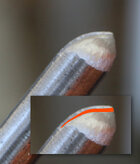I just ripped a 36" long strip of dry, 1" thick red oak. Below is typical of what gets left on the black tires, more on the bottom tire. ... maybe that big dog dust system you have on your saw keeps things cleaner than the mediocre dust collection by way of a shop vac these saws have.
Hmm. Maybe the DC helps. But I think tire brushes help more. I used the Delta 14" with riser for a bunch of years with just a shop vac or an open garage door and a fan.
Do you have stiff brushes that clean the tires while running? I made brackets, cut apart and modified a stiff-bristled brush, and mounted brushes in contact with the upper and lower tires, positioned so they contacted the tires just before they rotated into contact with the blade. This was on the Delta 14" before I got the 18" Rikon. The Rikon came with a brush mounted.
I don't think I ever replaced the tires on the Delta. (I did do a complete workover to make the wheels precisely coplanar, stronger tenson spring and tension block, cool-block guides, and quick tension release.) I processed a LOT of green wood on that saw to make turning blanks for drying.
I had to replace the tires on the Rikon a few years ago and put on some of those pretty orange Sulpher Grove urethane tires. The original Rikon tires didn't hold up like those on the Delta.
Softwood dust often contains sticky resins. Thickly packed sticky sawdust builds up horribly on inside of my Woodmizer blades every time I saw pine. I came up with a safe method to clean it off quickly while the mill is running. If I don't clean it off, the blade will dive in the cut Zero problems with hardwoods.
JKJ

